

Florida Trip, January 2006

Pictures from the trip can also be found in my gallery.
In the following, underlined species are year birds, and the sites are in bold. See further down the page for links to sites and descriptions of them. There were no life birds on this trip.
This brief (2.5 day) trip was originally planned to get Fork-tailed Flycatcher at the Apopka kingbird roost, but this bird vanished more or less at the exact moment I booked my flight. Therefore I still did the trip but ranged further afield. A Groove-billed Ani was reported from that site on 1/29, a day I had not planned to go there.
Saturday: Flew from Newark to Orlando on Jan 28th - delayed in transit due to air traffic radar issues. Got on the road by 11am. From Orlando Rt-528 (tolls) west to Rt-92 south (Sandhill Cranes in the median strip) to Brinson Park in Kissimmeee where I quickly found a whole bunch of year birds including two sought-after Limpkins - this small park had a lot of activity. I proceeded on via St Cloud and south on Canoe Creek Road. A wrong turn took me over the Turnpike into a quieter area (Kissimmee Park) where there were more Sandhill Cranes. Back-tracking and taking Old Canoe Creek Rd, I finally crossed the Turnpike again at the right spot and made an immediate right onto Lake Cypress Road. This dirt road had Crested Caracara in the first field but not much else further down the road except more Sandhills. Another Caracara was a few miles south along Canoe Creek Rd shortly before I turned onto Joe Overstreet Rd which held yet more Sandhills but no Whooping Cranes.
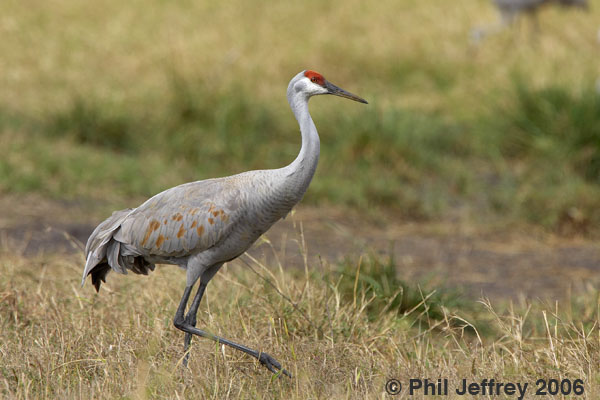
An assortment of herons at the boat ramp included the first of many White Ibis for the trip, along with Loggerhead Shrike. Continuing further down Canoe Creek Rd I turned into the first entrance of Three Lakes WMA which did not produce the hoped-for Red-cockaded Woodpecker but did yield Yellow-rumped, Palm and Pine Warblers, Common Yellowthroat, Eastern Bluebird, House Wren and Chipping Sparrow. Further down Canoe Creek Rd at the Prairie Lakes entrance were much the same species. (In retrospect the majority of Red-cockaded Woodpecker clusters are on the other side of Canoe Creek Rd).
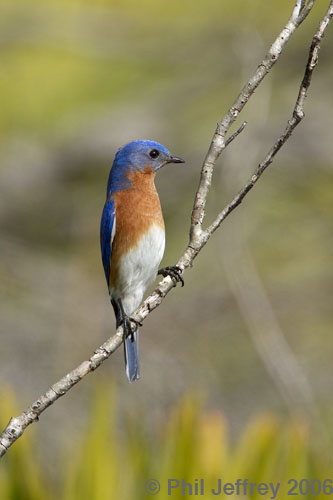
A sub-optimal choice of "short cut" made me arrive at Merritt Island NWR at Titusville later in the day than I wanted, but the place was quite active with Caspian Tern, Blue-winged Teal, American Bittern, Reddish Egret, Long-billed Dowitcher, Wood Stork, Roseate Spoonbill and even a single Snow Goose. There were enough opportunities there that I skipped both Orlando Wetlands Park and the Apopka kingbird roost in favor of remaining until sundown and taking photos. At dusk I headed west to Orlando and on to Tampa to stay at a Motel 6 at the I-4/Rt-301 junction (adequate, cheap) rather than drive further to Bradenton.
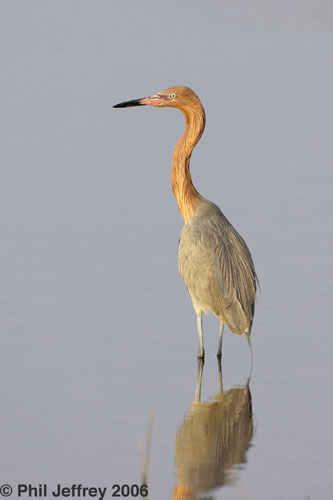
Sunday: I left east Tampa at 6am for a 75 mile "sprint" down I-75 to Venice. Taking the Jacaranda exit (#193) I got to the Venice rookery at 7:20am. The light was poor, and there were photographers there already, apparently willing to try photographing anything in whatever light. Activity was lower than I remember at the end of Feb 2001, but may have been a time-of-year issue. I did get a few shots of Cattle Egret when a little sun peeked through.
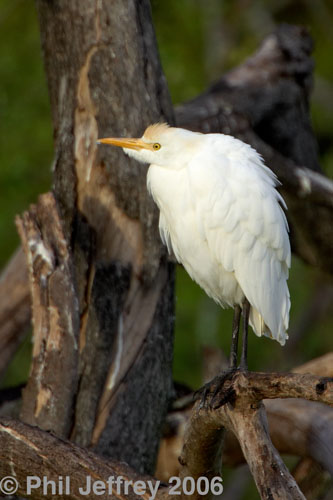 Cattle Egret |
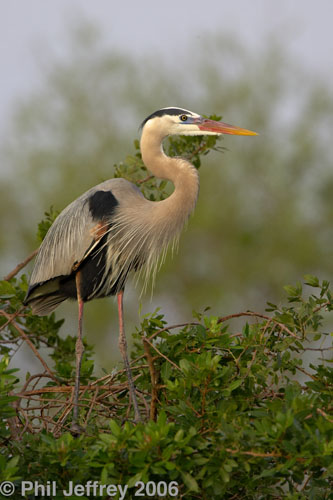 Great Blue Heron |
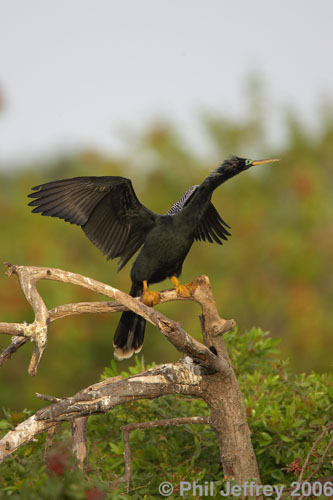 Anhinga |
I finally gave up on Venice Rookery at 8:20am due to poor light with no sign of clearing and headed north to Myakka River State Park ($3).
Myakka was pretty quiet in terms of people, especially compared to the swarms that were there in 2001 at the tram concession. The spillway held a single cooperative Limpkin (finally saw one here!) and other wading birds, as well as Savannah Sparrow.
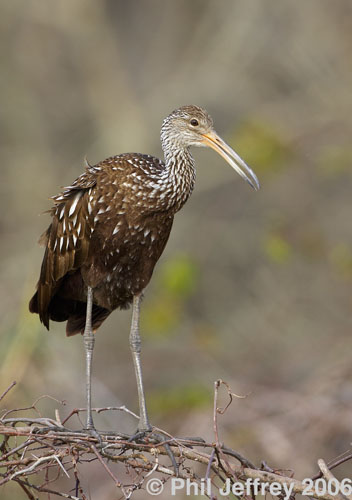
However the shoreline up to the birding boardwalk had only a single Snowy Egret. From the bird boardwalk itself I saw Caspian Tern, Least Sandpiper, Long-billed Dowitcher, yellowlegs sp, and two Sandhill Cranes. A single Wood Stork was seen from SR-72 on my way towards the park and I had a possible Caracara fly-over back-lit by the morning sun (and me at 55mph).
After Myakka I went back down towards Venice to Oscar Scherer State Park ($4) where it was extremely crowded and noisy since they were having some sort of event there (a so-called Pow-Wow). Only a brief time at Oscar Scherer was needed to figure out that these were very poor conditions to birdwatch in - hundreds of people and some very bad music - plus the wind was getting up. So I abandoned the park and headed south on I-75 toward Ft Myers.
At SR-82 I took a "short-cut" to Corkscrew Swamp ($10) via Immokalee - this is probably slightly faster if coming from the north via I-75 but the road is potentially quite slow. Development continues apace in the general area - one wonders what the long-term prospects for this place are. The southern part of Immokalee was bustling. Corkscrew wasn't too busy for a weekend afternoon, but the swamp was relatively quiet and the most productive part of the boardwalk was closed because of Wood Stork nesting. Nevertheless some good birds were seen: Painted Buntings at the feeders, Yellow-throated, Prairie and Black-and-white Warblers, a single Great Crested Flycatcher was heard but not seen.
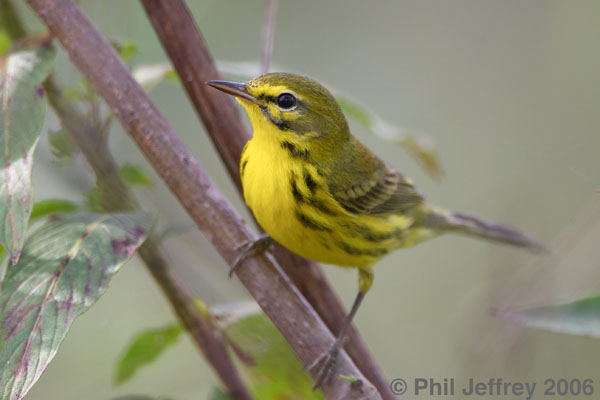

No Barred Owls and very few Wood Storks (as flyovers) and only a few herons and ibis along the boardwalk.
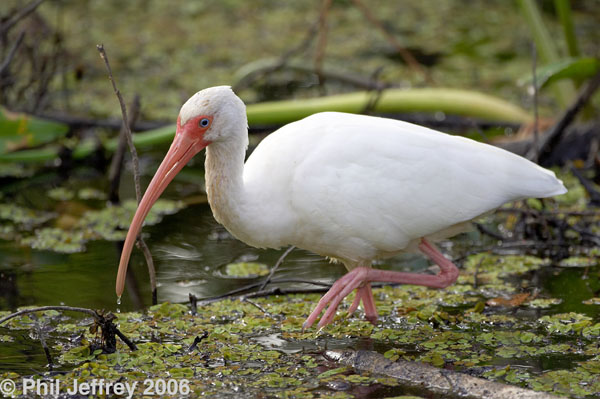
I left Corkscrew around 4:30pm but decided it wasn't worth it trying to chase to Sanibel for sundown, so just went and found a hotel for the night (Super8, relatively expensive, but coffee maker in room and continental breakfast starting at 6am). Note: Motel6 was booked out (on a Sunday, by noon).
Monday: I left the hotel at 6:20am to make it to Sanibel Island at the east end (lighthouse) by dawn. There was a decent amount of traffic in Ft Myers at this time on a Monday morning. Already at 7am there were people on the beach collecting shells and there was not a ton of birds. Nevertheless Common Loon, Red-breasted Merganser, Willet, Ruddy Turnstone, Sanderling, Royal Terns all put in an appearance and a Pileated Woodpecker was near the lighthouse itself.
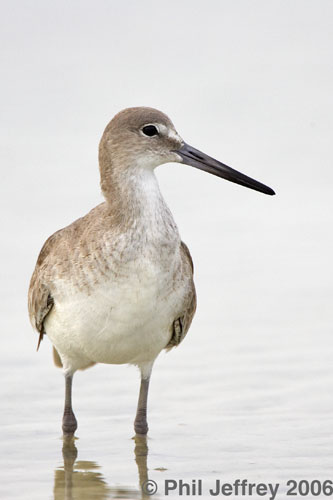
The condition of the trees illustrated quite well just how hard this area was hit by the hurricanes of late 2005 although the facilities themselves had been well repaired. The light was pretty bad (cloudy) so by 7:45am I left the now crowded beach for Ding Darling NWR.
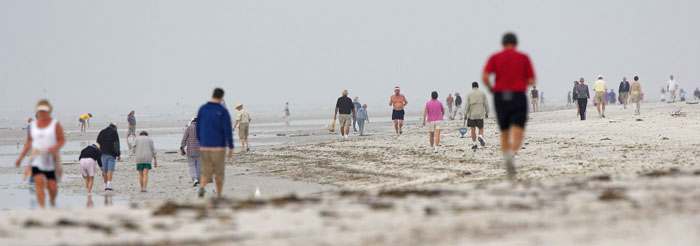
I found two Common Ground-Doves in the Ding Darling NWR visitor center parking lot and another one wandering around on the wildlife drive (as in, right on the drive walking around in front of my car).

Activity at Ding Darling was pretty slow, although it had my first Yellow-crowned Night Herons for the trip and several Roseate Spoonbills. The light was poor and the herons were not particularly cooperative. I did find a Yellow-bellied Sapsucker at the Shell Mound and Eurasian Collared-Doves were fairly numerous on the wires (and elsewhere in Fort Myers).
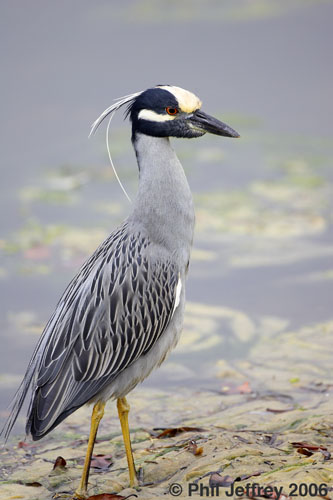
I spent a brief amount of time at the Bailey Tract of Ding Darling, and found only the second Anhinga of the day and flyover Wood Stork but it did not have much hold on me due to rising wind and somewhat of a dearth of birds. I left Sanibel and skipped Estero (shorebirds) and Cape Coral (Burrowing Owls) in favor of driving north on I-75. The light was pretty awful at this point with heavy overcast and threatening rain.
I revisited Venice (the only place in sunshine that day) and found the Shamrock Park Nature Center on Shamrock Drive (west of Rt-41 just south of the point where Rt-41 and Business Rt-41 split). This site is relatively new (1988) and has 5 families of Florida Scrub-Jays and one cooperative individual was right behind the visitor center doing the "sentinel" thing that I've seen Scrub-Jays do at Oscar Scherer. I did not find other Scrub-Jays but didn't spend too long looking for them.
I returned to Jacaranda Blvd via Center St and then I-75 north once more. I took I-275 across the bridge to St Petersburg and from that looped out in Rt-682 to Fort DeSoto Park. Short of time I spent perhaps only 10-15 minutes on the beaches themselves but scanned the North Beach and came up with Royal and Forster's Terns, Dunlin, Sanderling, Red Knot, Black-bellied Plover, several Short-billed Dowitchers, Black Skimmer. This site looks potentially useful. In the freshwater ponds just north of Fort DeSoto was a large concentration of Redhead, Lesser Scaup, Ring-necked Duck with a few American Coot and a single Northern Shoveler - there may have been more there but I was short of time to scan thoroughly. Returning to I-275 and chugging through Tampa to I-4, there was rain most of the way up I-4 to Orlando although the traffic eased out a little once outside Tampa.
It had been my intention to visit the Apopka kingbird roost late in the day for a low-probability stab at the Fork-tailed Flycatcher (not found by others) but distance, time and weather were against me. My DeLorme map was relatively old, didn't show the new toll express road to Apopka (SR-429 from Ocoee at the Turnpike to Apopka itself) which would have let me bypass the worst parts of US-441. Traffic in the middle or Orlando on I-4 was bad, and along US-441 was very bad. A couple of wrong turns trying to escape the traffic were enough to make me end up at the site as it was too dark to do much with it. The area to the north-west of Orlando bounded by SR-429 seems destined to become another suburban extension of Orlando, given that it's quite a way along that path already.
In any event, I repacked my stuff, returned the rental car to Thrifty (relatively efficient although off-airport) and returned to Newark via a relatively empty plane that arrived 30 minutes early. Continental Airlines were pretty efficient on this trip even with a full flight on the way out (they boarded the plane early). The air traffic issues on the outbound flight were out of their control.
Every time I go to Florida, there's always new development and especially always new pieces of habitat that are chopped up for new homes and apartments. The pace of development has not slowed and it appears that eventually the whole thing will become suburbia with vestigial wildlife refuges on the more marginal land.
| Common Loon | Sanibel |
| Pied-billed Grebe | Merritt Island NWR, Sanibel |
| American White Pelican | Merritt Island NWR, Sanibel |
| Brown Pelican | Sanibel |
| Double-crested Cormorant | |
| Anhinga | Corkscrew, Merritt Island NWR, Sanibel |
| American Bittern | Merrit Island NWR |
| Great Blue Heron | |
| Great Egret | |
| Snowy Egret | |
| Little Blue Heron | |
| Tricolored Heron | |
| Reddish Egret | Merritt Island NWR, Sanibel |
| Cattle Egret | |
| Green Heron | Merritt Island NWR |
| Black-crowned Night-Heron | Corkscrew, Sanibel |
| Yellow-crowned Night-Heron | Ding Darling NWR |
| White Ibis | |
| Glossy Ibis | Brinson Park |
| Roseate Spoonbill | Merritt Island NWR, Ding Darling NWR |
| Wood Stork | Merritt Island NWR, Corkscrew, Ding Darling NWR |
| Black Vulture | |
| Turkey Vulture | |
| Snow Goose | Merritt Island NWR |
| Mottled Duck | Merritt Island NWR only |
| Blue-winged Teal | Merritt Island NWR, Ding Darling NWR |
| Northern Shoveler | Merritt Island NWR, Fort DeSoto |
| Northern Pintail | Merritt Island NWR |
| Green-winged Teal | Merritt Island NWR |
| Redhead | Fort DeSoto |
| Ring-necked Duck | Fort DeSoto |
| Lesser Scaup | Fort DeSoto |
| Hooded Merganser | Meritt Island NWR, Myakka |
| Red-breasted Merganser | Sanibel |
| Osprey | |
| Bald Eagle | Joe Overstreet Rd and a few other places |
| Northern Harrier | |
| Sharp-shinned Hawk | Myakka River State Park |
| Red-shouldered Hawk | many locations |
| Red-tailed Hawk | one or two road-side locations |
| Crested Caracara | Cypress Lake Rd |
| American Kestrel | |
| Common Moorhen | Brinson Park, Merritt Island NWR |
| American Coot | |
| Limpkin | Brinson Park, Myakka River State Park |
| Sandhill Crane | Many locations Kissimmee area, Myakka River St Pk |
| Black-bellied Plover | Myakka River State Park, Sanibel, Fort DeSoto |
| Killdeer | |
| Black-necked Stilt | Merritt Island NWR, Myakka River State Park |
| American Avocet | Merritt Island NWR |
| Greater Yellowlegs | Myakka River State Park, Merritt Is NWR, Sanibel |
| Lesser Yellowlegs | Myakka River State Park, Merritt Is NWR, Sanibel |
| Willet | Sanibel |
| Spotted Sandpiper | Ding Darling NWR |
| Ruddy Turnstone | Sanibel |
| Red Knot | Fort DeSoto |
| Sanderling | Sanibel, Fort DeSoto |
| Dunlin | many at Merritt Island NWR, Fort DeSoto |
| Least Sandpiper | Myakka River State Park |
| Long-billed Dowitcher | Merritt Island NWR, Myakka |
| Short-billed Dowitcher | Fort DeSoto |
| Laughing Gull | Sanibel |
| Ring-billed Gull | various |
| Herring Gull | one or two at Joe Overstreet Rd |
| Great Black-backed Gull | Sanibel |
| Caspian Tern | Merritt Island NWR, Myakka |
| Royal Tern | Sanibel, Fort DeSoto |
| Forster's Tern | |
| Black Skimmer | Merritt Island NWR, Fort DeSoto |
| Rock Pigeon | Tampa |
| Eurasian Collared-Dove | Fort Myers etc |
| Common Ground-Dove | Ding Darling NWR |
| Belted Kingfisher | |
| Red-bellied Woodpecker | |
| Downy Woodpecker | Three Lakes WMA |
| Yellow-bellied Sapsucker | Sanibel |
| Northern Flicker | Merritt Island NWR |
| Pileated Woodpecker | Corkscrew Preserve, Sanibel Lighthouse |
| Great Crested Flycatcher | heard only at Corkscrew Preserve |
| Eastern Phoebe | Sanibel, Venice |
| Loggerhead Shrike | farmland |
| White-eyed Vireo | Corkscrew Swamp (heard also elsewhere) |
| Blue-headed Vireo | Corkscrew Swamp |
| Florida Scrub-Jay | Shamrock Park in Venice |
| American Crow | |
| Fish Crow | |
| Tree Swallow | |
| Carolina Wren | |
| House Wren | Three Lakes WMA |
| Blue-gray Gnatcatcher | |
| Eastern Bluebird | Three Lakes WMA |
| American Robin | |
| Gray Catbird | |
| Northern Mockingbird | |
| Brown Thrasher | Corkscrew Swamp |
| European Starling | (relatively few) |
| Yellow-rumped Warbler | often abundant |
| Pine Warbler | Three Lakes WMA, Corkscrew Swamp |
| Palm Warbler | |
| Prairie Warbler | Corkscrew Swamp |
| Yellow-throated Warbler | Corkscrew Swamp |
| Black-and-white Warbler | Corkscrew Swamp |
| Common Yellowthroat | Three Lakes WMA, Corkscrew Swamp |
| Chipping Sparrow | Three Lakes WMA |
| Savannah Sparrow | Myakka River State Park |
| Northern Cardinal | |
| Painted Bunting | Corkscrew Swamp feeders |
| Red-winged Blackbird | |
| Common Grackle | Corkscrew Swamp |
| Boat-tailed Grackle | |
| American Goldfinch | Corkscrew Swamp |
Trip list total: 111 species in 2.5 days
Myakka River State Park
The park is located 9 miles east of I-75 in Sarasota along State Road 72,
Sarasota, FL. (941) 361 6511.
Entrance fees were $3.00 per vehicle 1/2006 (just me). Open everyday,
8:00 AM until Sunset. About 60 miles south of Tampa; 15 miles east of
Sarasota, 9 miles east of I-75. Best locations are the spillway off
the tram/concession overflow parking lot, and the shoreline before the
Clay Gully bird boardwalk.
Oscar Scherer State Park
1843 S. Tamiami Trail, Osprey, FL.
(941) 483-5956
Oscar Scherer State Park is located on U.S.41,
south of Sarasota. Heading south on I-75 take exit 198 (rt 681) and
follow signs to Osprey.
Heading north on I-75 take exit 195 (Laurel Rd). About 10 miles south of Sarasota.
The park opens 8am, closes sunset. $4 fee per vehicle.
Venice Rookery
The Venice Rookery is on Route 41 in Venice
a short block west of Jacaranda Blvd and south of Rt-41.
(south-west of Jacaranda/Rt-41 intersection).
The entrance road is an Annex between a Florida Highway Patrol (police)
building and the Sarasota County Courthouse. About 15 miles south of
Sarasota.
To reach the Venice Rookery from Interstate 75, take exit 193 at
Jacaranda Blvd. Travel southwest for about five miles along Jacaranda
and turn right
onto Route 41 heading west/north. As soon as you complete that right turn,
get into the left lane and make the first left turn. You'll enter a
small street called the Annex between the Highway Patrol building and
the courthouse. Proceed for several hundred feet and the rookery will
be on the right side. Parking is in a paved lot on the left. There is now
a covered picnic structure on the site. Best at dawn.
Ding Darling NWR, Sanibel Island
Wildlife Drive - five miles; one-way drive with interpretive signs.
observation tower and pavilion. Open to pedestrians and bicyclists
sunrise to sunset every day except Friday. The front gate opens to
vehicles 7:30am and closes sunset. $5
entrance fee, CLOSED FRIDAYS. Sanibel accessed via Fort Myers/Cape Coral
via Summerlin Rd (avoid McGregor) with connections to Rt-41 and I-72 via
Cypress Parkway/Daniels Parkway, Cypress Lake Parkway. DO NOT TAKE
McGREGOR which is much slower.
Lighthouse at the southern tip of Sanibel Island good at dawn and perhaps dusk. Turn left after causeway at 4-way stop sign. Parking is $2/hour.
Ding Darling Bailey's Tract: South on Tarpon Bay Road from Bailey's Store (corner Periwinkle Way/Tarpon Bay Rd). Entrance on right approx. 1/2 mile. Clapper Rail, Sora, Sedge Wren, Wilson's Snipe at Ani Pond and Sanibel Gardens.
Estero Lagoon/Ft. Myers Beach
To reach Estero/Ft. Myers beach, go north on Hwy 41 to Bonita Beach
Road (about 15 miles north of Naples) and turn left. Or get off at exit
?? (old #18) on I-75 and head west. Estero Beach Lagoon is located behind the Holiday Inn. (Park across the
street in the winter if the parking lot seems full). You would never
guess that one of the top birding spots in Florida is 100 yards away as
you drive down this congested road. There is an extremely wide beach to
the north and a lagoon to the south. The beach may have 200+ Skimmers
in the winter. Also look for Sandwich and Royal Terns.
Corkscrew Swamp Sanctuary
375 Sanctuary Road West,
Naples, FL.
Telephone: 941-348-9151. $10 fee.
Hours December 1 through April 30: 7 AM to 5:30 PM
About 10 miles east of I-75 Naples via Immokalee Rd (846?), or
from north of Ft Myers as SR-82 into Immokalee
and south out of Immokalee on Rt-846. Wood Storks nesting off boardwalk in 2006
resulted in some boardwalk closure.
Briggs Nature Center
Hours Monday - Saturday, 9 a.m. - 4:30 p.m. On Rt 951 south of I-75 just
after it turns east.
Adults $7.50; (Admission is good for both the Briggs Nature Center and
the Naples Nature Center if visited within seven days.) No longer definitive for
Shiny Cowbird.
Fakahatchee Strand State Preserve
Fakahatchee Strand Preserve State Park is located on Janes Memorial Scenic Drive,
just west of Copeland on S.R. 29.
Copeland is north of Tamiami Trail between Naples and Shark Valley.
Loxahatchee NWR
NPS site.
Arthur R. Marshall Wilderness (Loxahatchee) is off Boynton Beach Blvd.
West of the Turnpike then south on 441, turn at Lee road
GORP link
Hours - every day except xmas from sunrise to sunset. Visitor
center is 9am-4pm weekdays, -4:30pm weekends. Reserve itself is 5am-6pm.
SOME HURRICANE DAMAGE.
WakodahatcheeWetlands
The Wakodahatchee Wetlands are located in suburban Delray Beach on the
east side of Jog Road between Woolbright Road and Atlantic Avenue (Exit
Route 95 onto Atlantic Avenue West; continue to Jog Road; turn right;
park is on the right) The site is on the southeast side of Palm Beach
County Water Utility Department's Southern Region Operations Center at
13026 Jog Road, Delray Beach. The wetlands are open to the general
public from sunrise to sunset, seven days a week. No admission
charge.
Green Cay
Another filter marsh about 1 mile NW of Wakadohatchee. Called Green Cay (proun. "key"),
it's much bigger and more open, attracting an interesting mix. Same boardwalks, etc.,
and a nature center.
Located at 12800 Hagen Ranch Road about a mile and a half south of Boynton Beach Boulevard,
or 2 miles north of Atlantic Avenue in Delray Beach. Open sunrise to sunset.
No admission charge.
Shark Valley/Everglades
Shark Valley hours are 8:30 am to 6:00 pm. First tram 9am. Best along the outbound (straight) tram road in the mornings in the first 200-300 yards. The Snail Kite roost to the west of the entrance at the abandoned airboat ride still seems to be active in 2006.Anhinga Trail/Everglades National Park Service hours etc. Mracek Pond, Mahogany Hammock, Eco Pond/Flamingo - FAIRLY EXTENSIVE CLOSURES IN EFFECT AT FLAMINGO. The main entrance is open 24 hours per day.
FL Keys Wild Bird Center, 93600 Overseas Highway, Tavernier - rehab place that attracts some wild birds (e.g. Wurdemanns).
Brian Piccolo Park - no current dedicated website
9501 Sheridan St., Cooper City, FL 33024.
Tel: (954) 437-2600
As of 2002: Winter Park Hours 8 a.m.-6 p.m. beginning the last Sunday in October.
From I-95, exit at Sheridan (about 2 exits south of Ft.
Lauderdale airport) and head west for probably 4-5 miles. You'll see
signs for the park. From I-95, exit at Sheridan (about 2 exits south of Ft.
Lauderdale airport) and head west for probably 4-5 miles. You'll see
signs for the park. It's a big multi-purpose park with lots of open
fields. The burrowing owl burrows are clearly marked and cordoned for
their protecton. Naturally, despite the fact that this is an open
public parkground, normal bird photography etiquette applys. They
collect $1 per person entry fee on weekends.
The campus of Florida Atlantic University in Boca Raton is locally famous for its population of Burrowing Owls. I believe the Burrowing Owl is the schools's mascot. Images of the little critter appear on all kinds of Florida Atlantic things. Their burrows can be found in the fields all around the perimeter of the campus.
Burrowing Owl Locations from 2002 article
Shamrock Park in Venice also has Florida Scrub-Jay. Follow Rt-41 north/west out of the rookery site. Shortly before Rt-41 and Rt-41 Business split, take Shamrock Drive to the west (left). Follow this for about 1.7 miles to the Shamrock Park Nature Center on the right. Taking Center St to the west off Jacaranda should put you into Rt-41 just north of Shamrock Dr.
Eagle Lakes community Park se of Naples: Bronzed Cowbirds in 2/2004. Shiny Cowbirds in 2/2002. From the junction of C.R. 951 (Collier Blvd.) and U.S. Rte. 41 in Naples, go north on U.S. Rte. 41 for approximately one mile until you see the sign for the park on your right. Park near the sports field. Walk east until you see the mitigation impoundments. There are three total with the best one being the one with the Bald Cypress trees in it.
Bachman's Sparrow: in Ocala State Forest Riverside Island & around Lake Delancy in the northern part of the forest are really good for Bachman's. Also anywhere there are trees marked for Red-cockaded Woodpeckers is usually good habitat. I've heard them singing as early as mid to late February. Make sure you know the song beforehand.
Apopka Kingbird roost: Directions: From S.R. 441 (Orange Blossom Trail) between Apopka + Zellwood, turn south C.R. 437. Continue going South CR-437 past Lust Rd, 0.9 miles Hooper's Farm Nursery on right. Kingbird roost on left along Power lines in back of field. (DeLORME p.79). Park and pull off between Orange grove and field. Birders beware, road is 55 m.p.h! Scope needed for good viewing. Fork-tailed Flycatcher seen 5:15-5:40 PM as of mid-Jan. Birders please stay along road as not to disturb the birds coming to roost. Ash-throated Flycatcher seen at Lust Rd gate to Apopka. May also see birds a little north of the roost across from Harmon Rd. I-4 to Turnpike north to Ocoee/SR-429 (toll), follow SR-429 north to Apopka, left onto SR-441 and left within the next mile or two onto CR-437. SR-429 is not shown on older maps (e.g. my DeLorme).
Orlando Wetlands park: A water reclamation system east of Orlando off SR50 with a small reception area. Large open ponds with extensive fresh water marsh. From Orlando, drive east on SR-50 to Christmas. Go north 2.3 miles on Fort Christmas Road (CR-420), then 1.5 miles east on Wheeler Road (an unpaved road). The parking area is on the left. Another neat place is the little parking lot across the street from the entrance to OWP - the Seminole Ranch property.
Disney Wilderness Preserve (Nature Conservancy). Over 11,000 acres of wetlands, flatwoods, scrubs, creeks, lakes, and trails. Phone (407) 935-0002 - Entrance is at Scrub Jay Trail, off Pleasant Hill Rd., 1/2 mile west of Poinciana Blvd. Go left on Scrub Jay Trail to Visitors Center and parking. From I-4: exit onto Hwy. 535 and head south. Follow 535 to Poinciana Blvd. Turn right (south) onto Poinciana Blvd. Follow Poinciana Blvd. approximately 15 miles until you reach the intersection of Poinciana Blvd. and Pleasant Hill Road. Turn right onto Pleasant Hill Rd. Approx 1/4 mile, turn left onto Old Pleasant Hill Road from a left-hand turn lane. Watch for these landmarks: sign for Old Pleasant Hill Rd., green "The Nature Conservancy," sign and a large Poinciana sign on stone work on the right-hand side of the road opposite of the turn. After turning left, go a 1/2 mile to Scrub Jay Trail. Turn left and follow Scrub Jay Trail to The Nature Conservancy's Conservation Learning Center.
Brinson Park Drive south on US17/92 into downtown Kissimmee then east onto CR525 Neptune road, the park is shortly reached and is the area where the highway bisects two areas of water, the large Lake Tohopekaliga is to your left. (Snail Kite, Limpkin).
Cypress Lake Road: located approx. 15 miles south of Kissimmee off highway 523 (Canoe Creek Rd). An area of rough grassland, mixed pine forest, boat ramp overlooking lake. Crested Caracara, Sandhill Crane and Loggerhead Shrike. Joe Overstreet Road: this area is located a further 5 miles or so south of Cypress Lake off Highway 523 (Canoe Creek Road) a similar habitat to that of the Cypress lake plus grazed farm land leading down to Lake Kissimmee. (Caracara etc) This is the road to Three Lakes WMA.
Threelakes Wildlife Management Area): Habitat of scattered pines over a vast area with large tracts of open land. Specialities: Red-cockaded woodpecker - nesting clan at the entrance gate - look through the scattered pines for trees with white rings painted around them then just wait from a sensible distance, Crested Caracara, Bachmans Sparrow - best seen in a large open area about 3/4 mile into the reserve. Take US441 south east out of Kissimee then CR523 south at St Cloud on Canoe Creek Road for approx. 23 miles to find the entrance to your right (sign posted). Route also passes road to Cypress Lake and Joe Overstreet. [Alt directions: From Kenansville, take Florida Highway 523 (Canoe Creek Road) 9 miles northwest. Park entrance is on the left (west).]
Boggy Creek Airboat: 192 East to Poinciana Blvd. Make a right on Poinciana Blvd and go 19 miles south until it dead ends. (Poinciana will change names to Southport Rd.) (Snail Kite). This seems to be just below the Disney Preserve.
Honeymoon Island (HMI), Gulf coast north of Tampa. Shorebirds and landbird migration.
Red-cockaded Woodpecker: Ocala NF, crossroads of CR-314 and FR-88 approximately three miles south west of Salt Springs. At Three Lakes WMA: fed noisily along the Florida Scenic trail approximately 100 yards from the entrance to Prairie Lakes (see map Pranty p.155)
Lake Kissimmee State Park (Pranty p.158) (Reddish Egret, Scrub-Jay)
Sea-watching at Turtle Mound on the Atlantic coast (Pranty p.175)
Clay Island, west side of Lake Apopka, had many Snipe along Canal section on 1/24.
From trip report: Collier Co Rt 92 into Marco Island for Mangrove Cuckoo (unspecified pull-offs). Mangrove Cuckoo at Rowdy Bend in Everglades. Mangrove Cuckoo also reported from Ponce de Leon Park in Punta Gorda (4000 W. Marion Avenue) in mangroves near the flats [Pranty p. 188].
Ft. Lauderdale site for Smooth-billed Ani: From Ft Lauderale take the Griffin Road exit from I-95 - just south of I-595. Go east on Griffin Road over the bridge, then go to the first traffic light and turn left into I believe its Beltway Park? Follow the road in and back to the parking lot, park here and then walk north to the fence of the park. Here you will be looking towards the Ft. Lauderdale Airport, look up or down the fence and hedge of the airport for the birds. If you don t see them this way walk east on the paved walking path until you do see them. Sometimes the birds are in the park itself.
Spot-Breasted Orioles can often be found in the Native Planting area of Kenwood Elementary School. From U.S. 1 in South Miami, turn west on Kendall Drive (also called SW 88th St.), go 0.3 mile and turn left on SW 79th St. Go about 0.2 mile to the Kenwood Elementary parking lot on the right, and park. Walk south between the two white school buildings and enter the Native Planting area. Look for the Oriole, and also Red-Whiskered Bulbuls, in the vicinity. The Oriole is also commonly found at A.D. Barnes County Park, located at Bird Road (SW 40th St.) and S.W. 72nd Ave. ALSO: Spot-breasted Oriole Tropical Audobon society grounds in Miami.
Baptist Hospital area in Kendall for exotics such as Spot-breasted Oriole, White-winged Parakeet, Red-whiskered Bulbul. (see Pranty).
Lucky Hammock: officially the Frog Pond WMA, local birders call the area "Lucky Hammock" because of the good fortune we have had birding there. From the end of the Turnpike at Florida City, take SR-9336 toward the main entrance of Everglades NP (follow Everglades signs). From Krome Ave, it is 8 miles to Aerojet Rd. Aerojet Rd is about 1/2 mile before the park boundary and 1/2 mile past the C-111 canal. There is a big sign for the Southern Glades Youth Camp. Turn left (south) on Aerojet Rd. Lucky Hammock is about 1/4 mile on the right. Bird the hammock and the shrubby area across the street. Check the fields. When you are done there, head further south to the sign for the Southern Glades WEA, which marks the end of Frog Pond WMA. The "Annex" is the area between the Southern Glades WEA sign and the gate just beyond the youth camp entrance. It also has good birding. The area further south of the gate only recently opened up.
BB and Fulvous Whistling-Ducks at STA-5 is south of Clewiston on the NW corner of Rotenberger WMA. From Miami: Get to Alligator Alley (I-75). Go west to Government (Snake) Road at the Miccosukee gas station. Take Government Road north to SR-832. Follow SR-832 west, north, and west to Blumberg Road. Take Blumberg, which quickly turns south, for about 9 miles to the STA-5 turnoff (dirt road). Go south for another 2 1/2 miles on the dirt road to the STA-5 entrance gate. Park before the gate in the area to the right. Alternate route: From I-75, take US-27 north to South Bay. Contiue west on US 27 from South Bay toward Clewiston for about 13 1/2 miles. Look for Evercane Road (CR 832) and the J & J Ag. Products sign. Continue south on CR 832 for about 9 1/2 miles to Blumberg Rd (at the second bend in the road). Turn left onto Blumberg and continue another nine miles to the STA-5 turnoff (dirt road). Go south for 2 1/2 miles on the dirt road to the STA 5 entrance gate. Park before the gate in the area to the right.
Sarasota Celery Fields: Snipe, Sora etc